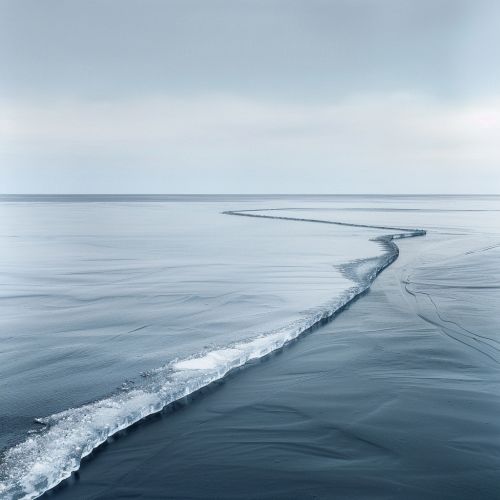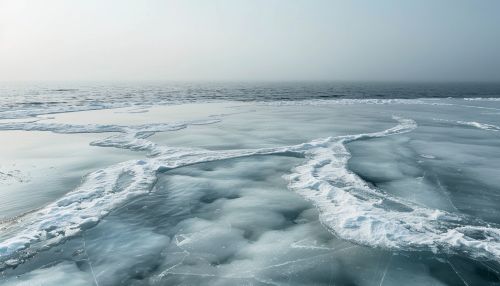Nilas
Introduction
Nilas is a type of sea ice that forms in calm, cold conditions. It is characterized by its thin, elastic nature and its ability to bend without breaking. Nilas plays a significant role in the polar regions, influencing both the local ecosystem and global climate patterns. This article delves into the formation, characteristics, and ecological significance of nilas, as well as its interactions with other forms of sea ice.


Formation
Nilas forms under specific environmental conditions, primarily in calm, cold waters. The initial stage of nilas formation begins with the cooling of the ocean surface, leading to the development of a thin layer of ice known as frazil ice. As the temperature continues to drop, these frazil ice crystals coalesce, forming a continuous sheet of nilas. This process is facilitated by the absence of strong winds and waves, which would otherwise disrupt the formation of a smooth ice layer.
Thermodynamic Processes
The formation of nilas is governed by thermodynamic processes, including heat exchange between the ocean and the atmosphere. As the ocean loses heat to the colder atmosphere, the surface water temperature drops, leading to ice formation. The rate of heat loss and subsequent ice formation is influenced by factors such as air temperature, humidity, and wind speed.
Salinity and Brine Rejection
Salinity plays a crucial role in the formation of nilas. As seawater freezes, it expels salt, a process known as brine rejection. This increases the salinity of the underlying water, which can affect the buoyancy and stability of the forming ice. The expelled brine can also create channels within the ice, influencing its structure and properties.
Characteristics
Nilas is distinguished by several unique characteristics that set it apart from other types of sea ice.
Thickness and Elasticity
Nilas is typically very thin, with a thickness ranging from a few millimeters to several centimeters. Despite its thinness, nilas is highly elastic and can bend without breaking. This elasticity allows nilas to conform to the shape of the underlying water surface, creating a smooth, continuous ice cover.
Color and Appearance
Nilas has a distinct appearance, often described as dark and glossy. This is due to its thinness and the presence of underlying water, which gives it a darker hue compared to thicker, more opaque ice types. As nilas thickens, it may transition to a lighter color, indicating the presence of more ice and less water.
Growth and Transformation
Nilas can grow and transform into thicker ice types through a process known as congelation. As additional layers of ice form on the underside of the nilas, it gradually thickens and loses its elasticity. This transformation is influenced by factors such as temperature, salinity, and the presence of snow cover.
Ecological Significance
Nilas plays a vital role in the polar ecosystems, providing habitat and influencing the distribution of various marine species.
Habitat for Microorganisms
The underside of nilas provides a unique habitat for a variety of microorganisms, including algae and bacteria. These organisms form the base of the polar marine food web, supporting higher trophic levels such as zooplankton and fish. The presence of nilas can therefore have cascading effects on the entire ecosystem.
Impact on Marine Mammals
Marine mammals, such as seals and polar bears, rely on sea ice for various aspects of their life cycle, including breeding, resting, and hunting. The formation and persistence of nilas can influence the availability of suitable habitat for these species, affecting their distribution and behavior.
Influence on Primary Production
Nilas can also impact primary production in polar regions by influencing light penetration and nutrient availability. The thin, translucent nature of nilas allows some light to penetrate, supporting photosynthesis by ice-associated algae. Additionally, the process of brine rejection during nilas formation can enhance nutrient availability in the underlying water, promoting primary production.
Interactions with Other Sea Ice Types
Nilas does not exist in isolation but interacts with other forms of sea ice, influencing the overall dynamics of the ice cover.
Formation of Pancake Ice
In rougher conditions, nilas can break up and form pancake ice, a type of ice characterized by circular, disk-shaped pieces. This transition occurs when wind and wave action disrupt the smooth surface of nilas, causing it to fracture and form individual ice floes. Pancake ice can subsequently coalesce to form thicker, more stable ice types.
Transition to First-Year Ice
As nilas thickens and undergoes congelation, it can transition to first-year ice, a more robust and stable form of sea ice. This process involves the accumulation of additional ice layers and the incorporation of snow cover, leading to increased thickness and structural integrity.
Interaction with Multiyear Ice
Nilas can also interact with multiyear ice, which is older and thicker than first-year ice. When nilas forms adjacent to or on top of multiyear ice, it can influence the overall stability and dynamics of the ice cover. The presence of nilas can affect the melting and freezing processes, as well as the distribution of brine and nutrients within the ice.
Climate Implications
The formation and dynamics of nilas have important implications for global climate patterns.
Albedo Effect
Nilas has a lower albedo, or reflectivity, compared to thicker ice types. This means that it absorbs more solar radiation, contributing to the warming of the ocean surface. The albedo effect of nilas can influence local and regional climate patterns, as well as the overall energy balance of the polar regions.
Feedback Mechanisms
The presence of nilas can also contribute to various feedback mechanisms that influence climate change. For example, the formation of nilas can lead to increased brine rejection, which can enhance ocean circulation and heat transport. Additionally, the melting of nilas can contribute to the freshening of the ocean surface, affecting salinity and density-driven circulation patterns.
Monitoring and Prediction
Understanding the formation and dynamics of nilas is crucial for monitoring and predicting changes in the polar regions. Satellite observations and in-situ measurements are essential tools for tracking the extent and properties of nilas, providing valuable data for climate models and forecasts.
Conclusion
Nilas is a unique and important component of the polar sea ice cover, with significant implications for the local ecosystem and global climate. Its formation, characteristics, and interactions with other ice types highlight the complex and dynamic nature of the polar regions. Continued research and monitoring are essential for understanding the role of nilas in the broader context of climate change and polar ecology.
See Also
- Sea Ice
- Frazil Ice
- Pancake Ice
- First-Year Ice
- Multiyear Ice
- Albedo Effect
- Brine Rejection
- Polar Regions
